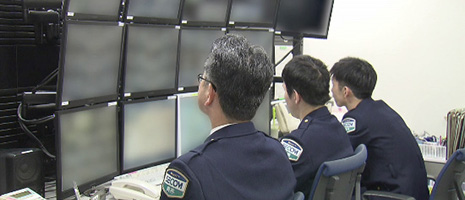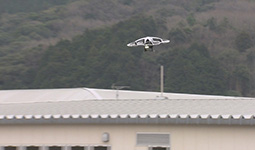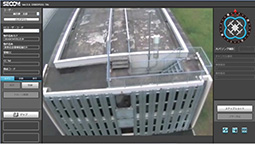Home > Highlighting JAPAN > Highlighting Japan January 2018 > Sustainable Technologies from Japan
Highlighting JAPAN


The World’s First Drone for Private Security
A leading Japanese security company has developed a security service that uses drone technology.
SECOM Co., Ltd., which provides services for protecting the security of people’s lives, has developed SECOM Drone, the world’s first autonomous small-sized flying security robot for civil crime prevention, and began providing services in 2015.
Since the 1990s, SECOM has researched and developed original small-sized planes for security, gaining insights from the method of spraying agricultural chemicals mid-air by helicopter. The reasons behind this development were due to an increasing number of short-time or rapid crimes such as burglary, and to improve the quality of security services for protecting people’s daily safety and security.
Under SECOM’s conventional security system, sensors are installed on the doors of the buildings, including both corporate and residential use, and the users will arm the sensor or switch the sensors into alert mode when they leave the premises. If a suspicious person or vehicle enters the premises and the sensors detect an intrusion, security staff will dispatch to the site to check for any abnormality. However, in some cases, as a certain time is necessary for the security staff to reach the site, they could arrive only after the suspicious person or vehicle has already left the premises. In order to solve this problem, SECOM invented a security system of having drones standing by within and outside the building. Under this system, if a drone detects intrusion, it begins chasing the intruders and shoots pictures of the number plate of the car and the suspicious person using a pre-installed camera. Even if the suspicious person runs away, the video image captured by the camera can be used for chasing and capturing the escaping person. The drone security enables crime scenes to be checked quickly, which leads to high-quality security services. In addition, it can also reduce the number of company security staff who are standing by for dispatch to the crime scenes.
Seiya Hasegawa, Senior Manager of the Corporate Planning Division for Open Innovation, says, “In 2012, when we announced the concept of developing a security system using drones, drones were not yet popular in Japan. At that time, we used a German-made indoor drone as an experimental model, but to utilize drones for our security services, we needed drones with a technology to fly autonomously within the facility of customers and even to fly outdoors, regardless of the weather conditions and time. Since such drones did not exist in the market at that time, we decided to develop them by ourselves.”
To realize fully autonomous flying drones, SECOM studied and researched technology of the drone system. SECOM implemented comprehensive measures to prevent drones from flying over the customers’ premises at any time and adopted encrypted radio communications as a measure to prevent drone hacking. As one of SECOM’s group companies possesses a technology of creating three-dimensional map information (see here), the company applied this technology and uploaded the information to the originally developed drones. This enabled a drone to chase someone suspicious by avoiding obstacles within the premises, and also prevented it from flying beyond the customers’ property.
The background of these measures being taken was due to the partial revision of the Civil Aeronautics Act enacted in December 2015 that restricts drones flying over people or areas where houses are concentrated. This legal revision occurred just before the completion of SECOM Drone, after the company had announced its concept three years ago.
Hasegawa says, “The revision of the Civil Aeronautics Act was a big surprise for us. To avoid a situation in which we had to stop our services due to the violation of the law shortly after launching long-awaited new services, we postponed the release of SECOM Drone. When the revised Civil Aeronautics Act was enacted on December 10, 2015, we made an application for the very first model and after gaining official permission, we were able to start our drone service officially.”
Currently, SECOM is conducting a demonstration test of drones patrolling along a designated route. If this technology becomes fit for practical use, the company will be able to have drones flying around the buildings for patrolling instead of humans, and the security staff will monitor the drone’s live image at the control center. If any suspicious flying object is detected on the roof of the premises, it can be checked easily by simply adjusting the flying height of the drone.
SECOM operates businesses in twenty countries and regions, and conducts security business in twelve of these. The company is considering the overseas operation of SECOM Drone, complying with the Civil Aeronautics Acts and Radio Laws in each country.
A new technology, SECOM Drone will contribute to realizing a more secure world in the near future.
© 2009 Cabinet Office, Government of Japan









